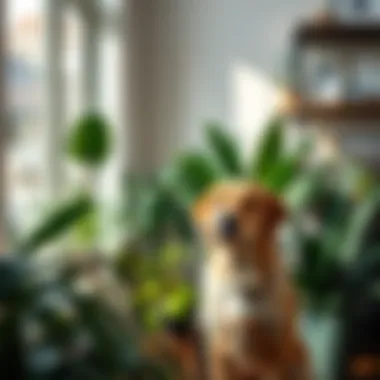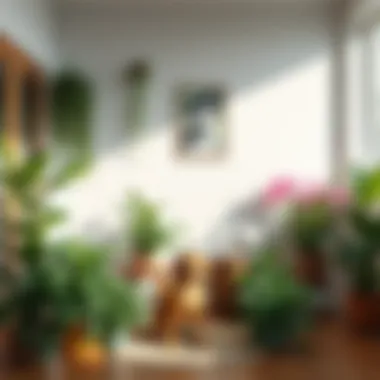Top Indoor Plants That Are Safe for Dogs


Intro
When it comes to decorating your home, the choices are endless. But for dog owners, the task can be a bit trickier. The desire to add greenery often clashes with the need to keep our fur babies safe. This article delves into a thoughtful selection of indoor plants that not only beautify your living space but are also safe for dogs.
Many people might have a nagging worry about plants being toxic to their pets. The truth is, there are numerous varieties that enhance aesthetic appeal without posing any danger to our canine companions. By incorporating these plants into your home, you can create a vibrant environment that helps keep your dogs secure.
From the gentle beauty of the Spider Plant to the cheerful Bamboo Palm, each of these selections comes with its own unique characteristics. We will explore their care needs, benefits, and best practices for integrating them into your home—the kind of tips that can turn your ordinary interior into a lush paradise, all while keeping your furry family members happy and healthy.
Why Choose Dog-Friendly Plants?
Adopting dog-friendly plants doesn't just remove the risk of toxicity; it also adds a layer of responsibility in cultivating a safe home. Bringing greenery indoors can enhance moods, improve air quality, and contribute to a serene atmosphere. By making the right choices, you can thread the needle between functionality and safety.
Moreover, besides visual appeal, these plants can be talking points, helping create a warm and inviting atmosphere when friends or family come over. Who wouldn’t want to hear a story about the quirky history behind a Snake Plant or the care tips for a Parlor Palm?
To kick things off, we’ll start with design inspirations that showcase just how harmonious indoor plants and pet safety can coexist.
Prologue to Dog Friendly Indoor Plants
Creating a home that accommodates both lush greenery and furry companions often feels like a balancing act. The right indoor plants can enhance your living space, but when dogs are in the picture, the stakes grow higher. In this article, we delve into the significance of selecting dog-friendly plants. Choosing the right plants not only safeguards the health of your canine friends, but it also adds a touch of nature to your interiors, bringing life and freshness into the home.
Importance of Choosing Safe Plants
The heart of the matter lies in the plant selection. Certain plants can pose serious health risks to dogs, leading to ailments that can range from mild to severe. For instance, plants like Pothos and Azalea can cause anything from gastrointestinal upset to more dire health complications when ingested. Therefore, it becomes crucial to familiarize oneself with which plants are poisonous and especially important to opt for varieties known to be safe.
By making informed choices, you bring peace of mind into your home. Picture this: you come home after a long day, seeing your beloved pooch blissfully lounging next to the Spider Plant you just added. Knowing that every plant is a safe choice creates a stress-free environment for both you and your pup.
Impact on Home Environment
Bringing greenery indoors is more than just an aesthetic choice. Plants have a way of transforming spaces into serene havens. They can purify the air, reduce stress, and even improve mood. But when you choose dog-friendly plants, you're doing more than simply enhancing your space's visual appeal; you're fostering a harmonious living environment for your entire family, including your pets.
Consider the beauty of a Boston Fern hanging in your window. Not only is it non-toxic to dogs, but it also absorbs pollutants, improving air quality. This dual benefit reinforces the idea that while you’re integrating natural beauty into your home, you’re also contributing positively to your household's atmosphere.
Understanding Plant Toxicity
Understanding plant toxicity is a crucial aspect for any dog owner considering adding greenery to their living space. Many plants may seem innocent at first glance, but a closer look could reveal a potential threat to our furry companions. Dogs, being curious by nature, often explore their environment with their mouths. Hence, it’s important to know which plants are safe and which could lead to harmful consequences.
When selecting indoor plants, consider the impact humanity's choices have on pet safety. Not all plants are created equal; some harbor toxic compounds that can lead to severe health issues for dogs, including vomiting, diarrhea, and even more serious conditions. An awareness of these toxic plants helps you make informed decisions, fostering a harmonious environment that pleases both pet and owner.
Additionally, an understanding of plant toxicity goes beyond just avoiding harmful plants. It empowers pet owners to curate a vibrant and safe space, enhancing the quality of life for both the dog and the family. Here’s a closer look at why it's pivotal to be informed about specific toxic plant varieties and how to recognize the signs of poisoning should a mishap occur.
Common Toxic Plants to Avoid
Some common household plants harbor toxic properties that can pose significant risks to dogs. Here are a few plants that should be avoided:
- Sago Palm: Just a small quantity can be lethal, leading to severe liver failure.
- Azalea: Ingesting this can cause gastrointestinal upset and heart issues.
- Oleander: All parts are toxic, and ingestion can lead to serious heart conditions.
- Philodendron: Chewing can cause irritation and swelling of the mouth and throat.
- Lily: Particularly dangerous, as it can cause kidney failure in dogs.
It's important to keep these plants out of your living space if you share it with a dog. If you have any doubts, do your research or consult a veterinarian. Always err on the side of caution.
Signs of Plant Poisoning in Dogs
Recognizing the signs of plant poisoning is essential for prompt treatment. If you suspect your dog has ingested a toxic plant, look for these signs:
- Vomiting: Often one of the first symptoms to appear, asserting that your dog might have ingested something undesirable.
- Diarrhea: Often accompanying vomiting, this can lead to dehydration.
- Lethargy: A sudden lack of energy or enthusiasm can signal distress.
- Excessive drooling or pawing at the mouth: This may indicate irritation or discomfort.
- Difficulty breathing: A serious symptom that requires immediate attention.
If you notice any of these symptoms, especially after your dog has been near a plant suspected to be toxic, do not wait. Reach out to a veterinarian right away.
Being aware of these signs and knowing which plants to steer clear of creates a safer home for your canine companion. With caution and informed choices, houses can flourish with the beauty of indoor plants without endangering those we adore.
Top Dog Friendly Indoor Plants
Choosing plants that are safe for dogs is not just about aesthetics; it’s about creating a space where your furry friends can roam freely without the danger of harmful toxins. Homeowners and renters alike are increasingly aware that the green life within their walls should not come at a cost to their pets' health. The top dog friendly indoor plants combine beauty with the assurance of safety, allowing for a harmonious living environment without the worry.


The benefits of adding these plants are manifold. For one, they improve air quality, help reduce stress, and are straightforward to care for, often thriving even under less-than-perfect conditions. Including dog friendly plants in your home gives you the peace of mind that your beloved pet can explore and interact with the surroundings without any harmful consequences.
Spider Plant
Care Tips
Spider plants are renowned for their resilience, making them a popular choice among plant enthusiasts. They thrive in indirect sunlight but can also tolerate lower light levels, so you don’t need to fret about finding the ideal spot. A simple watering every couple of weeks is generally enough, as these plants prefer to dry out between waterings. Overwatering is the main foe here, leading to root rot, which is a common pitfall.
One appealing aspect of spider plants is their ability to propagate easily, producing 'babies' that can be repotted. This characteristic not only makes them a budget-friendly option but also offers an opportunity for plant lovers to share the joy with friends. Thus, the low maintenance of spider plants and their propensity to grow can make them feel like a gift that keeps on giving.
Aesthetic Qualities
With their long, arching leaves that resemble a vibrant green fountain, spider plants can bring a lively touch to any room. They can be displayed in a hanging basket or on a shelf, where the leaves spill over, making a striking visual impact. The contrast of green with the white stripes on their leaves adds texture and depth, helping to elevate the overall aesthetic of your home.
Boston Fern
Care Tips
Boston ferns prefer high humidity environments, so they thrive in bathrooms or kitchens where moisture is naturally higher. To keep them happy, mist them regularly or place a tray of water and pebbles beneath their pot to increase humidity around them. They appreciate indirect light but should be shielded from harsh sunlight to avoid browning.
Caring for Boston ferns can be a bit more involved compared to other plants, as they require consistent watering and humidity levels. However, for those willing to invest the time, they reward owners with lush, feathery fronds that can transform any dull corner into a green sanctuary.
Aesthetic Qualities
Boston ferns are admired for their bushy texture and bright green fronds. They can act as an elegant focal point in a room or cascade beautifully from a hanging pot. Their lush appearance instantly adds a touch of nature’s tranquility to indoor spaces, making them suitable for both minimalistic and vibrant decor styles.
Bamboo Palm
Care Tips
The bamboo palm thrives in low light conditions and requires moderate watering. Its ability to adapt to various situations makes it ideal for beginners or those with a less-than-perfect green thumb. Keeping the soil slightly moist without saturation is key.
This plant is also known for its air-purifying qualities, which is a wonderful bonus. Bamboo palms filter out harmful chemicals from the air, enhancing both the ambiance and quality of your home environment. Overall, care for this plant is straightforward, aligning perfectly with a busy lifestyle.
Aesthetic Qualities
Bamboo palms stand tall and proud, with slender stems and lush leaves, offering a tropical flair that elevates any space. Their graceful appearance and ability to grow up to several feet high can create stunning backdrops in larger rooms, adding richness without overwhelming the space.
Areca Palm
Care Tips
Ideal for indoor environments, the Areca palm needs bright, indirect light and well-draining soil. Keep the soil's top layer dry before watering again. One thing to consider is that this plant might require more frequent watering than others, especially during hotter months.
They can serve as natural humidifiers, which is especially beneficial for dry indoor air. If you’re looking for greenery that can also help keep the air around your home comfortable, the Areca palm ticks many boxes.
Aesthetic Qualities
Areca palms are known for their elegant, feather-like fronds that create a soft, bushy look. They can fit right into any decor scheme, evoking a calming tropical feel. An Areca palm can fill a corner beautifully, making it one of the more visually appealing options on this list.
Lady Palm
Care Tips
Lady palms are quite hardy and adapt well to their surroundings. They prefer moderate light and don’t require daily watering. In fact, letting the soil dry out slightly between waterings can benefit them. Their growth is slow but steady, creating a steady addition to your plant collection.
The fact they can tolerate varying light levels makes them especially convenient for homeowners, as they can be placed in various locations throughout the house. Overall, their low demands make them appealing for busy pet owners.
Aesthetic Qualities
Lady palms have a graceful appearance, with broad, lush leaves that can instantly draw the eye. Their dense foliage can create an impressive living wall effect or serve as organic decor in a living room, bringing in layers of green.


Parlor Palm
Care Tips
Parlor palms thrive in low to medium light conditions, which makes them excellent candidates for darker indoor areas. Overwatering can lead to issues, so sticking to a weekly watering schedule usually suffices. They don’t mind a bit of neglect, making them very user-friendly for those who might forget to give their plants a daily checkup.
Thanks to their forgiving nature, the parlor palm can be a trusty companion, thriving in an underappreciated space while requiring minimal attention.
Aesthetic Qualities
The parlor palm sports slender trunks and subtle fronds that provide a lovely, wistful aesthetic. Their compact size makes them suitable for small spaces, while still delivering a statement of greenery that can brighten any room.
African Violet
Care Tips
African violets prefer bright, indirect light and need to be watered from the bottom to prevent leaf spotting. They thrive with a bit of attention regarding humidity and temperature, ideally kept in a warm area away from drafts.
While they can be slightly more fussy than the other plants listed, the vibrant blooms they display make them worth the effort for any pet owner who enjoys a splash of color in their home. Their flower colors can vary, ensuring a beautiful surprise as they thrive.
Aesthetic Qualities
The beauty of African violets lies in their showy flowers that bloom in abundant clusters, creating striking pops of color against lush, green leaves. They add cheerfulness and energy to any space, serving as a welcoming sight for both homeowners and guests alike.
Cast Iron Plant
Care Tips
As the name suggests, the cast iron plant is a tough cookie. It can endure low light, neglect, and irregular watering. This makes it perfect for busy households where a lot can go on, as its resilience allows it to thrive where others might perish in a heartbeat.
The ability to survive varying conditions makes this a staple for anyone looking to improve their home decor without too much fuss. It’s the perfect low-maintenance choice for homes where life is always a little chaotic.
Aesthetic Qualities
The cast iron plant’s glossy leaves have a deep green hue that can harmonize with other decor elements. Their upright form adds elegance, which can frame various design styles from modern minimalist settings to more traditional homes.
Calathea
Care Tips
Calatheas are adored for their striking leaf patterns and colors, but they can also be a bit needy. They prefer bright, indirect light and require a moist environment. Keeping their leaves clean and regularly misted can help to maintain their vibrant look. However, being mindful of their water needs is essential, as they can easily show stress through browning leaves.
For pet owners, their vibrant aesthetics can be a joy, despite the additional care they might need.
Aesthetic Qualities
Calathea leaves are known for their captivating designs, featuring bold colors that can liven up any room. Their unique patterns lend themselves well to stylish decor, making them a favorite for interior designers and homeowners alike. The beauty they bring to spaces is undeniable, as they often serve as a conversation starter and point of interest.
Christmas Cactus
Care Tips
Christmas cacti thrive in lower light conditions and prefer to dry out between waterings — that's their sweet spot. They are quite forgiving, which makes them suitable for those who may not be plant experts. Regular care can lead to delightful blooms during the holiday season, adding cheer to your home.
Taking care of this cactus is straightforward, especially as it doesn't require much. Plus, its ability to produce vibrant flowers makes an appealing reason to engage with them closely.
Aesthetic Qualities
With delicate hanging flowers that bloom in colors such as pink, red, and white, the Christmas cactus can bring joy and brightness to any space. It can be displayed on shelves or in hanging pots, acting as a festive decoration that transcends the standard plant aesthetic, especially around the festive season.
Each of these plants offers unique benefits, creating not only a safer environment for your pets but also enriching your living space with vibrant, healthy greenery.


Integrating Plants into Dog-Friendly Spaces
When it comes to having both indoor plants and dogs in your home, finding harmony is pivotal. It’s not just about filling your space with vibrant greenery; it’s about ensuring that your four-legged family members can roam freely without risking their safety. This section delves into how to seamlessly incorporate plants into your dog's living environment while considering their needs and habits.
Placement Strategies
Strategically placing plants can make all the difference. Here are some tips to keep in mind:
- Elevate Your Greenery: Use high shelves or hanging planters to keep plants out of reach. Dogs with a penchant for mischief might be tempted to nibble, so elevation can prevent unwanted snacking.
- Room Zoning: Designate areas in your home where plants can flourish, yet remain dog-free. For instance, a corner in your living room dedicated to plants can become a beautiful focal point without risking your pet’s well-being.
- Avoid Popular Dog Routes: Avoid placing plants where your dog frequently walks or plays. Traffic hot spots can lead to accidents such as knocked-over pots or, worse, a plant being ingested. Think about the layout of your living space and anticipate your dog's movements.
- Choose the Right Containers: Consider pot designs with sturdy bases. Some dogs might see a pot as an intriguing toy, so opt for heavier pots that reduce the likelihood of tipping.
"A well-placed plant can elevate a space, but a well-thought-out placement ensures both safety and beauty."
Maintaining Plant Health with Pets Around
Maintaining the health of your plants while cohabitating with dogs requires some extra diligence. Here are some crucial strategies:
- Regular Inspections: Inspect your plants regularly for any signs of wear, pests, or distress. Dogs can inadvertently cause damage, so keeping a watchful eye helps in timely intervention.
- Avoid Toxic Pesticides: Opt for pet-friendly pest control solutions. Many commercially available pesticides contain harmful ingredients that can jeopardize your furry friend’s health. Research natural alternatives like neem oil.
- Establish a Routine: Develop a watering and care schedule that fits your lifestyle and minimizes interactions between your dog and the plants during upkeep. Timing can mean less stress for both parties.
- Educate Household Members: Everyone in the household should be aware of which plants are dog-friendly and how to care for them. This keeps all caretakers vigilant and committed to maintaining both plant health and pet safety.
Integrating plants into your home while keeping it dog-friendly is about balancing beauty with responsibility. Through strategic placement and mindful maintenance, a safe and vibrant environment can flourish. Plant lovers with pets need not fear; with a little forethought, a cozy, green indoor retreat can thrive.
General Care Tips for Dog Friendly Plants
Choosing dog-friendly indoor plants is just one part of the equation; ensuring they thrive in your home requires some attention to their care. This section addresses fundamental aspects of plant maintenance, particularly focusing on watering, lighting, and general upkeep. Not only does proper plant care contribute to a lush indoor environment, but it also keeps your four-legged friends safe and sound.
Investing time and effort into understanding the needs of your plants can enhance their health, contributing to a vibrant home atmosphere. Dog-friendly plants not only beautify your space but also purify the air, creating a wholesome environment for both humans and pets.
Watering and Lighting Needs
Understanding the watering and lighting requirements of your dog-friendly plants is crucial. Each type of plant has different needs that can influence its growth and, consequently, its safety and health in a home shared with dogs.
- Watering:
- Lighting:
- Some plants, like the Spider Plant, prefer to dry out between waterings, while others need more consistently moist soil. A few good rules of thumb include:
- Check soil moisture by sticking your finger about an inch into the soil. If it feels dry, it’s time to water.
- Be mindful of overwatering, which can lead to root rot. This is particularly important in homes with dogs, as stagnant water can attract pets.
- Bright indirect light works wonders for most dog-friendly plants. However:
- Spider Plants thrive in various light conditions, making them perfect for beginners.
- Bamboo Palm prefers part shade, so consider where you place it to ensure it gets adequate light without risking overexposure.
Ensuring a proper balance of watering and lighting not only keeps your plants happy but reduces the risk of attracting curious pets that might dig or chew.
Pruning and Maintenance
It’s essential to keep your dog-friendly plants trimmed and tidy. Regular pruning helps direct the plant's energy towards growth and keeps the foliage healthy. Below are some best practices on how to maintain your indoor plants effectively:
- Pruning Techniques:
- Regular Maintenance:
- Remove yellow or dead leaves to promote growth. This also prevents any potential hazards for pets—less clutter means fewer opportunities for curious noses.
- Use clean, sharp scissors to make clean cuts; this reduces stress on the plant and minimizes the risk of disease.
- Dusting leaves can help your plants photosynthesize better. A damp cloth can remove dust without damaging the foliage.
- Check for any signs of pests or disease. Early detection allows for easier management and decreases the chance of plants becoming a health risk to your pets.
Maintaining your dog-friendly plants may seem daunting at first, but with a little practice, it becomes second nature. Keeping your indoor plants healthy contributes to not just their vitality, but also to a safe and happy living space for you and your furry companions.
"A thriving plant is a happy plant, and a happy plant means a healthy home for all creatures great and small."
By incorporating these general care tips, you will ensure a refuge where your plant buddies flourish without posing any risks to your beloved pets.
End
When it comes to creating a home that feels welcoming and safe, the choices we make about the plants we bring indoors can greatly affect our environment, especially for those of us with furry companions. This article emphasizes the importance of selecting dog-friendly indoor plants not just for aesthetic appeal, but for the peace of mind it brings us as pet owners.
Choosing the right plants is about more than visual enhancement; it’s about ensuring the safety of our beloved dogs. The right greenery can create a sense of calm and warmth within the home. Plants like the Spider Plant and Bamboo Palm provide air-purifying benefits while posing no threat to curious canines. We have to remember that dogs tend to explore their environment with their noses and mouths, so incorporating these non-toxic options is key.
Furthermore, the integration of plants into our living spaces requires thoughtful consideration of placement and care. Maintaining plant health is crucial—not only for vibrant aesthetics but also for avoiding any situations where pets might be tempted to nibble on them. Understanding specific needs like watering and lighting can play a vital role in successful plant ownership.
"Creating a safe and harmonious environment means understanding the interplay between our pets and greenery. By choosing wisely, we can enhance our homes without jeopardizing their safety.”
Ultimately, when we select dog-friendly plants, we choose to foster a harmonious home. This not only showcases our style but also fosters a safe environment. The plethora of options available today allows homeowners to curate a lively, vibrant space that complements their life without compromising their dog's well-being.















